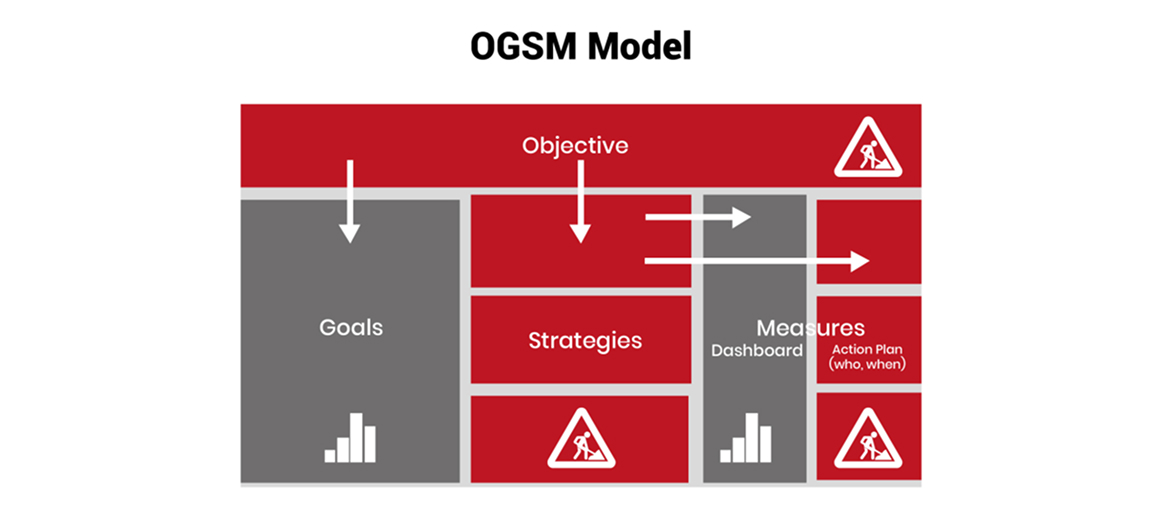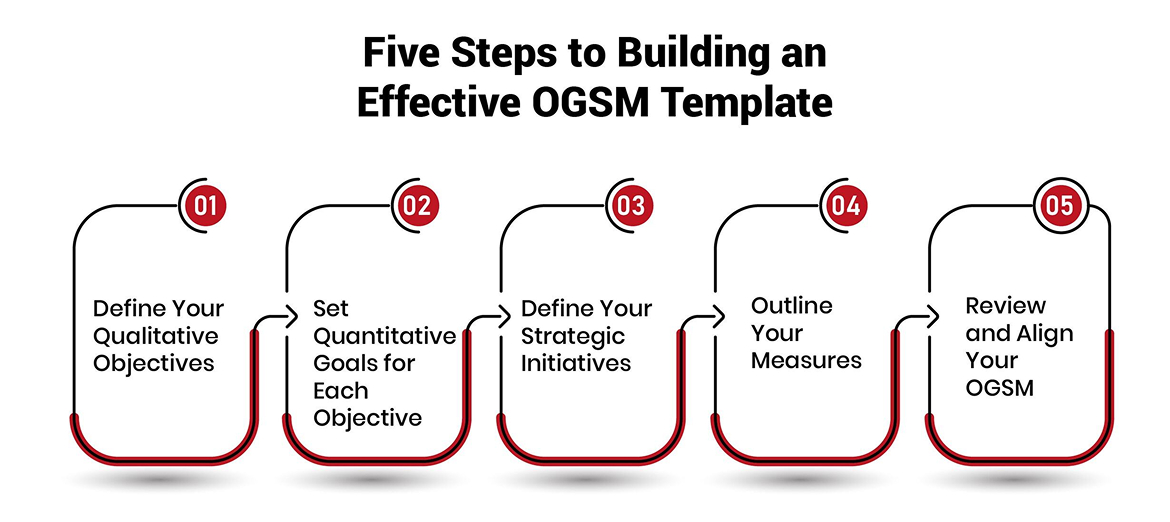Many businesses have great visions and goals for the future. But turning those ambitions into reality can be a major challenge without the right strategic planning. This is where the OGSM Model in business comes into play.
OGSM stands for Objectives, Goals, Strategies and Measures. It is a straightforward strategic planning framework used by organizations large and small to translate vision into action.
In this comprehensive guide, we’ll cover what exactly the OGSM model is, the step-by-step process for building an effective OGSM, and real-world examples of companies using OGSM to drive meaningful business results.

The OGSM model is a strategic planning technique used to map out high-level organizational ambitions into specific, measurable goals and strategies over a set timeframe, usually 3-5 years.
It has four key components:
The objectives component of the OGSM model refers to the qualitative end goal that an organization wants to achieve over a 3-5 year timeframe. Objectives should be:
Here is an example objective that meets the above criteria:
This objective clearly ladders up to an environmental sustainability mission. It is ambitious for a packaging company but attainable through product innovations. And it uses simple language that paints a vivid picture for all employees.
Goals represent the quantified, time-bound outcomes that indicate progress is being made towards the overarching objective. Effective OGSM goals are:
For the sample objective above, aligned OGSM goals could be:
These goals use specific metrics like percentages and timeframes that make it easy to evaluate success. They also tie directly to strategies around sustainable product redesign and manufacturing improvements.
Strategies outline the specific initiatives, projects, and actions that will be taken to accomplish the OGSM goals and objectives. Effective strategies have the following attributes:
Sample strategies for the sustainable packaging objective could include:
These strategies call out specific dollar figures, facilities, market segments, and timeline commitments that teams can organize around to drive progress on the related goals.
The measures component of the OGSM model refers to key performance indicators that are tracked over time to determine if the outlined strategies are successfully driving achievement of the goals and objectives. Effective measures exhibit the following:
For the sample sustainable packaging strategies, key measures could include:
By monitoring these percentages the teams can determine if the product R&D and redesign initiatives outlined in the strategies are truly having an effect. The measures provide the proof of execution.
While creating an OGSM requires some effort, the framework itself is straightforward. Simply follow these five steps to create an OGSM template:

Start by writing down the 3-5 major strategic objectives you want to accomplish over the next 3-5 years. These should be qualitative, vision-based statements that say what you want to achieve. Some examples:
With your objectives framed, get more specific by outlining measurable goals for each one centered around targets, timelines, volumes or percentages. For example:
a. Be the #1 provider of green energy solutions
b. Pioneer an innovative client experience
Now detail the high-level game plans – or strategies - required to hit those markers of success. These will likely involve launching initiatives around things like:
Measures quantify your progress towards goals through concrete KPIs. Good metrics to include are things like:
With an initial draft complete, scrutinize each component to ensure proper connectivity and flow. Objectives should drive goals, goals should inform strategies, and strategies should impact measures. Look for any weak links or gaps that could undermine execution. Refine as needed until satisfied.
Once finished, you have an OGSM template ready for execution! Be sure to revisit it at least annually to evaluate progress and realign as necessary.
To understand how impactful the OGSM methodology can be in activating business strategy, let’s look at a few real-world examples.
Procter & Gamble
Procter & Gamble (P&G) is a global consumer goods company with over $84 billion in annual revenue. As an early adopter and advocate of the OGSM (Objectives, Goals, Strategies, Measures) strategic planning model, P&G serves as an exemplary case study for implementing OGSM across a massive, complex organization.
P&G has fully integrated the OGSM methodology into its global strategic planning and management processes. This ensures alignment on priorities from the executive team down to country and brand teams.
P&G starts by defining 3-5 year objectives tied directly to the company’s overall purpose, values, and growth ambitions. For example, an objective may be “to achieve sustainable organic sales growth ahead of key competitors in priority markets.” Keeping the objectives tied to overarching corporate principles provides focus and guidance for goals and strategies.
Next, quantitative goals are established to measure progress towards the 3-5 year objectives. Goals are specific, ambitious, and timed, cascading from the corporate level to business units. An example goal would be “achieve 5% organic sales growth in Feminine Care category in North America by FY 2026.” Regional, country, and brand teams then further break down goals.
P&G develops strategies across businesses, brands, product categories, regions and functions all aimed at achieving the defined goals. Strategies may include product innovation pipelines, channel prioritization, pricing actions, media investment shifts, pack size architecture, and other tactical choices. Robust analysis informs strategic choices to allocate resources to highest potential opportunities.
Finally, P&G establishes regular tracking of key performance indicators (KPIs) to monitor progress versus goals and enable course correction if needed. Dashboards are created for different levels of the organization to maintain visibility into what’s working or needs adjustment. KPIs tracked depend on the objective but typically include consumer reach, market share trends, revenue and profit delivery, and other impact metrics.
P&G’s effective adoption of OGSM over decades has directly contributed to both consistent growth and strengthening of its competitive advantages:
Without OGSM, it would be nearly impossible for P&G leadership to effectively steer such a large global ship. OGSM provides the structure and discipline - from objectives to measures - to drive accountability and ownership at all levels.
Toyota
As the world's largest automotive manufacturer, Toyota has leveraged the OGSM (Objectives, Goals, Strategies, Measures) model as a core framework for strategic planning and operations. This has enabled the company to translate high-level objectives around quality and reliability into quantifiable goals, operational strategies, and performance measures.
Toyota has fully embedded the OGSM model into its global manufacturing and operational strategy, aligning high-level objectives with on-the-ground execution across plants, teams, and supply chains to ensure consistent quality and efficiency.
Toyota set a long-term qualitative objective to be viewed by customers as the most reliable and highest quality car brand in the world. This objective stems directly from founder Kiichiro Toyoda's vision that the automaker must make cars with the highest quality and durability.
Toyota translated its high-level objective into specific quantifiable goals around quality, production efficiency, and warranty claims. Setting measurable time-bound goals has enabled the company to benchmark progress and keep teams aligned around the long-term objective.
To achieve its quality and efficiency goals, Toyota deployed three core manufacturing strategies:
These interlinked strategies provide the foundation for Toyota to meet its objectives and goals.
To benchmark progress on its goals, Toyota established detailed performance measures down to the factory level, including:
These quantifiable measures have enabled Toyota's lean operations model, providing transparency into progress towards long-term goals.
Toyota's OGSM-driven strategy for manufacturing has led to industry benchmarks around operational excellence. Despite higher operating costs from predominantly domestic production, Toyota has achieved:
Through OGSM planning, Toyota has been able to continuously refine and improve its manufacturing system over decades. This has led to significant quality and efficiency improvements enabling Toyota to minimize costs while commanding premium pricing based on its reputation for reliability.
The OGSM methodology is invaluable for organizations looking to convert ambitious visions into executable strategic plans that yield real results. Some key lessons around activating strategy with OGSM:
By putting in the effort to develop a robust OGSM model, you gain the clarity, transparency and focus needed to cascade top-level aspirations into bottom-line impact – no matter the size or scale of your business.

CredBadge™ is a proprietary, secure, digital badging platform that provides for seamless authentication and verification of credentials across digital media worldwide.
CredBadge™ powered credentials ensure that professionals can showcase and verify their qualifications and credentials across all digital platforms, and at any time, across the planet.

Keep yourself informed on the latest updates and information about business strategy by subscribing to our newsletter.